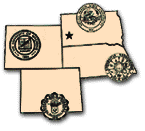Animal Science, Department of

Range Beef Cow Symposium
Date of this Version
December 1991
Document Type
Article
Abstract
Range cattle provide room and board for a large variety of flatworm and roundworm parasites. A parasite is by definition an agent that inflicts a degree of harm to a host, and the damage caused depends on the innate abilities, size of the population, duration of infection and other factors tied to the parasite. Host-related factors are also important, including breed, age, sex and condition. The damage to animals may be obvious, with clinical signs including diarrhea, loss of weight, “bottle jaw” (swelling under the jaw), rough hair coat, reproductive/breeding dysfunction and, in severe cases, feed waste due to an inability to digest protein, depressed lactation in cows and diminished immune response to viral, bacterial and mycotic opportunists.
The roundworms known as trichostrongylids are widely known to be the most common and economically important group of worms in cattle in the world (ARS, NRP #20420, USDA 1976). Members of the group inhabit the abomasum (Ostertagia species, Trichostronglus axei and Haemonchus species), small intestine (Cooperia species, Nematodirus species and Trichostrongylus colubriformis) and the lungs (Dictyocaulus species). They range from about the size of an eyelash to more than an inch in length and damage the lining of the organ they inhabit by burrowing through cell layers or feeding on blood or tissues. Although liver fluke or lungworm can be a significant problem in local areas, the magnitude of importance warrants focus on the abomasal/intestinal trichostrongylids, especially Ostertagia ostertagi the medium stomach worm.


Comments
Published for Proceedings, The Range Beef Cow Symposium XII December 3, 4 & 5, 1991, Fort Collins, Colorado.